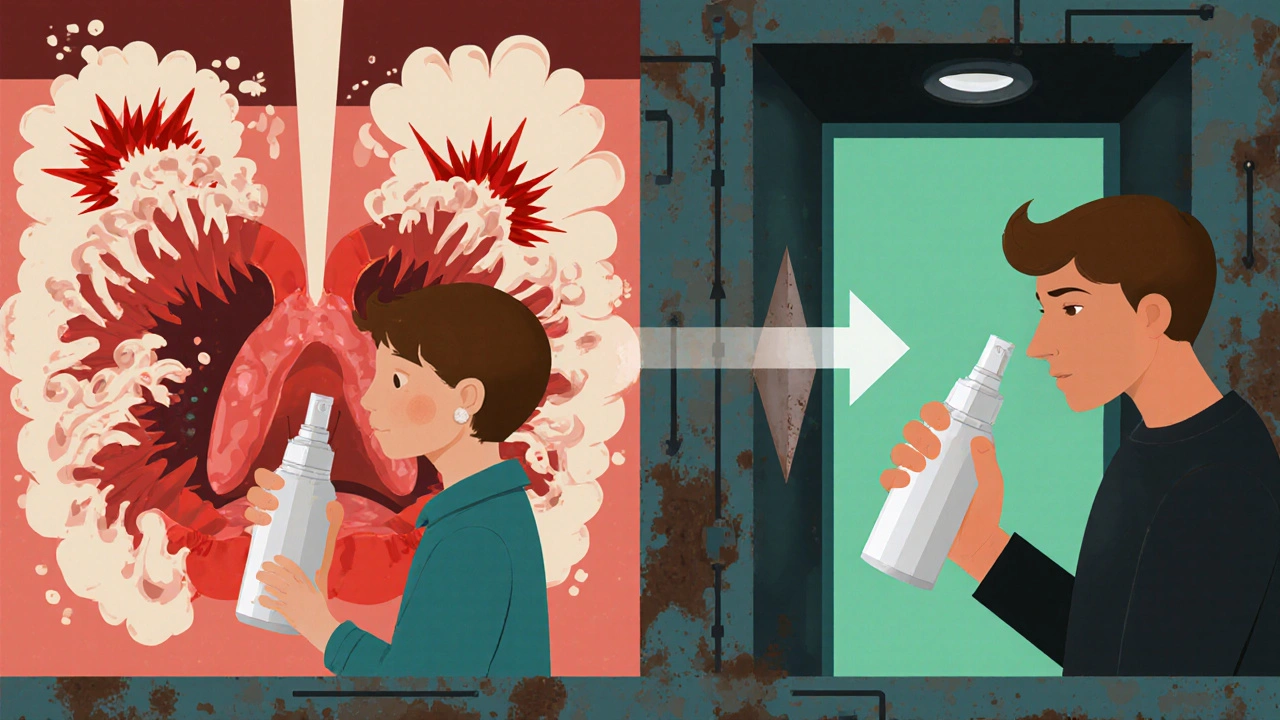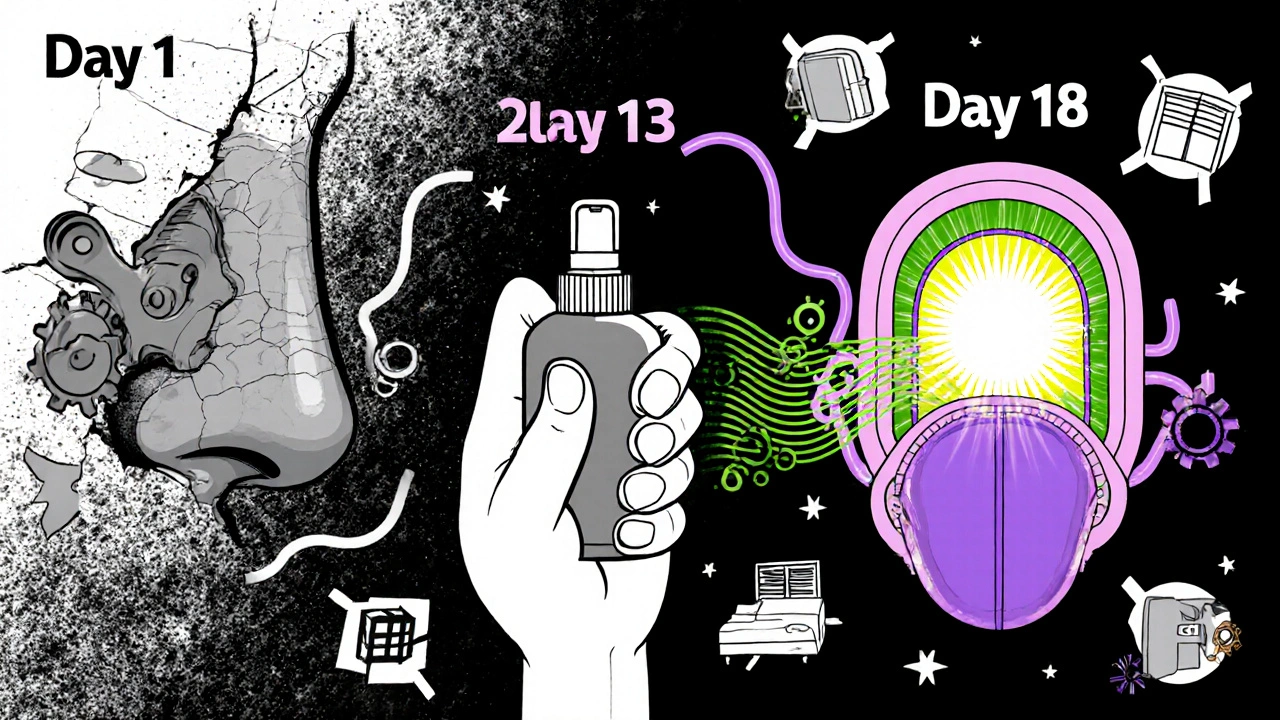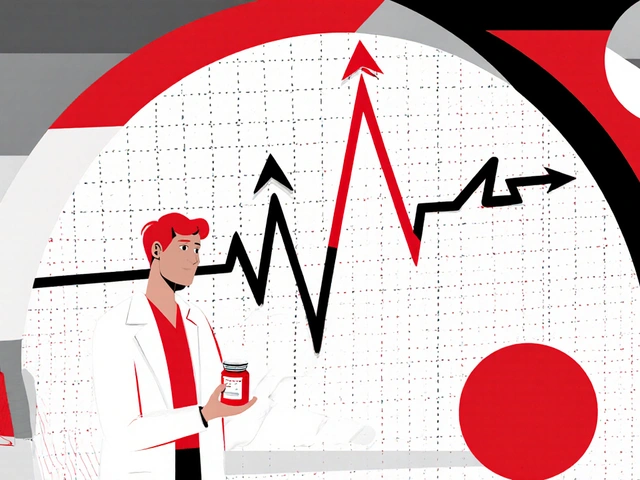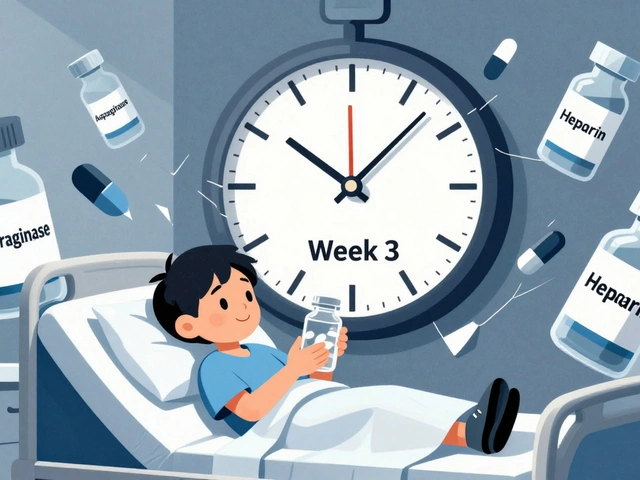
When your nose won’t stop running, your eyes itch, and you feel like you’re constantly sneezing, it’s not just a cold. It’s allergic rhinitis - and it’s more common than you think. Around 10-30% of people worldwide deal with it every year. For many, over-the-counter antihistamines help a little, but the real game-changer? Nasal steroid sprays. These aren’t just another spray you grab off the shelf. They’re the most effective, science-backed treatment for allergic inflammation - if you use them right.
How Nasal Steroid Sprays Actually Work
Nasal steroid sprays, also called intranasal corticosteroids (INSs), don’t just mask symptoms. They go after the root cause: inflammation. When you’re exposed to pollen, dust, or pet dander, your immune system overreacts. It releases histamine, cytokines, leukotrienes, and other chemicals that make your nasal passages swell, produce excess mucus, and trigger sneezing. Antihistamines only block histamine. Steroid sprays? They shut down the whole inflammatory cascade.
These sprays deliver a low-dose corticosteroid directly to the lining of your nose. From there, they reduce swelling, calm overactive nerves, and block the recruitment of immune cells like eosinophils and T-cells that keep the inflammation going. This is why they work for all four major symptoms: congestion, runny nose, sneezing, and itching - even itchy, watery eyes. No other single treatment covers this full range so effectively.
Why They’re Better Than Antihistamines and Decongestants
You’ve probably tried antihistamine pills or nasal sprays like azelastine. They help with sneezing and runny nose, but they barely touch nasal congestion. That’s because congestion comes from swollen tissues - not just histamine. Decongestant sprays like oxymetazoline give quick relief, but using them for more than 3 days can cause rebound congestion. Your nose gets worse when you stop.
Nasal steroid sprays don’t have that problem. Studies show they’re more effective than oral or nasal antihistamines, even when those are combined with leukotriene blockers. The American Academy of Otolaryngic Allergy says they’re usually one of the first-line treatments for moderate to severe allergies. Eighty-five percent of board-certified allergists recommend them. That’s not hype - it’s data.
And here’s the kicker: they work whether your allergies are seasonal (hay fever) or year-round (dust mites, pets). You don’t need to wait until symptoms hit. Prevention is part of the treatment.
When Do You Start Feeling Better?
Here’s where most people get frustrated. Unlike antihistamines that kick in within an hour, nasal steroids take time. You won’t feel relief on day one. Or day three. Most people start noticing a difference after 3-5 days, but full results often take 2-4 weeks of daily use.
This delay is why so many people give up too soon. They spray once or twice, think it’s not working, and stop. Then they wonder why their allergies are still bad. Consistency is everything. Think of it like brushing your teeth - skipping days makes the outcome worse.
One user on Reddit shared: “I used Flonase for two weeks and thought it was useless. Then I kept going. On day 18, I woke up and realized - I hadn’t sneezed once. That’s when it clicked.”

How to Use Them Correctly
Using these sprays wrong is the #1 reason people get side effects or no results. Here’s how to do it right:
- Shake the bottle well before use.
- Blow your nose gently to clear out mucus.
- Tilt your head slightly forward - don’t lean back.
- Point the nozzle away from the septum (the middle wall of your nose), toward the outer wall of your nostril, near your ear.
- Press the spray while breathing in gently through your nose.
- Don’t sniff hard or blow your nose right after.
Why point away from the septum? Because that’s the thin, sensitive area where nasal septal perforation - a rare but serious side effect - can happen if the spray hits it repeatedly. Most side effects like dryness, burning, or nosebleeds come from spraying too close to the center.
Pro tip: Use the spray after a hot shower or hold your head over a steamy sink for 5 minutes. The moisture helps reduce irritation and makes the spray feel smoother.
Side Effects and Safety
These sprays are among the safest long-term medications you can take. They’re designed to work locally - very little enters your bloodstream. That’s why they don’t cause the weight gain, mood swings, or high blood pressure that oral steroids can.
Common side effects? Dryness, mild stinging, or occasional nosebleeds. In a review of 1,843 users on Drugs.com, 62% reported positive effects, while 28% noted side effects - mostly dryness (24%) and nosebleeds (18%).
Severe side effects like nasal septal perforation are extremely rare - less than 1 in 10,000 users - and almost always linked to incorrect use. If you get persistent bleeding or pain, stop and see a doctor. But for most people, the risk is far lower than the benefit.

Who Can Use Them?
These sprays are approved for children as young as 2 years old. Dosing varies:
- Children 2-5 years: 1 spray per nostril once daily
- Children 6-11 years: Start with 1 spray per nostril daily; increase to 2 if needed
- Adults and teens 12+: 1-2 sprays per nostril once daily (follow label instructions)
Many brands - like Flonase (fluticasone), Nasacort (triamcinolone), and Nasonex (mometasone) - are now available over the counter. You don’t need a prescription. But if your symptoms aren’t improving after 4 weeks, talk to a doctor. You might need a stronger dose or a different approach.
What’s on the Horizon?
Researchers are working on sprays with even better delivery systems - ones that reduce contact with the septum even further. New formulations are being tested to lower irritation and improve absorption. Biologic drugs for severe allergies are emerging, but they’re expensive and reserved for the most extreme cases.
For the vast majority of people, nasal steroid sprays will remain the gold standard. They’re affordable, effective, and safe for long-term use. With rising allergy rates globally, they’re not going anywhere.
Real Talk: When They Work - and When They Don’t
These sprays are powerful, but they’re not magic. They won’t fix allergies caused by things you’re constantly exposed to - like a furry pet in your bedroom or mold in your basement. You still need to reduce triggers: wash bedding weekly, use HEPA filters, keep windows closed during pollen season.
They also won’t help if you’re not using them daily. One spray every other day? That’s like taking half a painkiller. It’s not enough.
And if you have chronic sinus infections, nasal polyps, or structural issues like a deviated septum, steroids might help with inflammation - but you’ll likely need more than just a spray.
Bottom line: If you’ve got persistent allergic symptoms, give nasal steroid sprays a real shot. Use them every day for at least 3 weeks. Use them correctly. Don’t expect instant results. And if you still feel stuck after that? See an allergist. There’s almost always a solution - you just need the right tool.
How long does it take for nasal steroid sprays to work?
Most people start noticing improvement after 3 to 5 days, but full relief usually takes 2 to 4 weeks of consistent daily use. They don’t work like antihistamines - patience is key.
Can children use nasal steroid sprays?
Yes, most nasal steroid sprays are approved for children as young as 2 years old. Dosage depends on age: 1 spray per nostril once daily for younger kids, and sometimes 2 sprays for older children if symptoms persist. Always follow the label or your doctor’s advice.
Are nasal steroid sprays safe for long-term use?
Yes. Unlike oral steroids, nasal sprays deliver a tiny amount of medication directly to the nose, with very little absorbed into the bloodstream. Long-term use is considered safe for most people, even for years. The most common side effects are mild nasal dryness or occasional nosebleeds.
What’s the difference between Flonase and Nasacort?
Both are over-the-counter nasal steroid sprays that work similarly to reduce inflammation. Flonase contains fluticasone propionate; Nasacort contains triamcinolone acetonide. Studies show they’re equally effective for most people. Choice often comes down to personal tolerance, price, or availability.
Do I need a prescription for nasal steroid sprays?
No. Popular brands like Flonase, Nasacort, and Rhinocort are available without a prescription in most countries. However, stronger doses or newer formulations may still require a prescription. Always check the label for age and dosage guidelines.
Can I use nasal steroid sprays with antihistamines?
Yes. Many people use both together - a steroid spray for congestion and inflammation, plus an oral or nasal antihistamine for sneezing and itching. They target different parts of the allergic response and are often combined under a doctor’s guidance for better control.
Why do I get nosebleeds from my nasal spray?
Nosebleeds usually happen when you spray too close to the middle of your nose (the septum), where the tissue is thin and easily irritated. To prevent this, aim the nozzle toward the outer wall of your nostril, not straight up or toward the center. Using the spray after a warm shower can also help keep the nasal lining moist.









10 Comments
Been using Flonase for 3 years now. My hay fever used to wreck my workdays - now I barely notice pollen season. The key? Daily use. No magic, just consistency. Also, aim the nozzle toward your ear, not your brain. Learned that the hard way.
Y’all need to stop giving up after 3 days 😭 I was skeptical too - then I kept going. Day 17? I woke up and my nose was actually QUIET. Like, I had to check if I was still alive. This stuff is a godsend if you don’t treat it like a suggestion.
How quaint. You all treat this like some miracle elixir, but let’s be honest - it’s just another corporate-sanctioned placebo wrapped in clinical jargon. The real solution? Get out of your allergen-filled suburban boxes. Move to a remote island. Breathe clean air. Or at least stop breathing through your nose. The spray? A Band-Aid on a bullet wound.
India has been using neem and turmeric nasal rinses for 5000 years and now you guys pay $30 for a plastic bottle? Pathetic. This spray is just a western scam. We don’t need your chemtrails in our nose. Wash with salt water like real humans.
From a respiratory immunology standpoint, the mechanism of action is unequivocally superior to H1 antagonists due to the downstream suppression of IL-4, IL-5, and eotaxin-mediated eosinophilic infiltration. The pharmacokinetics of intranasal corticosteroids demonstrate localized bioavailability with negligible systemic absorption - a paradigm shift in Type I hypersensitivity management.
you ever wonder if the FDA just let this happen so they can sell more sprays? i mean, why do all the commercials say 'use daily for 2-4 weeks'... why not just fix the air? or maybe the pollen is just a distraction... i heard they put stuff in the water too. my nose bleeds every time i use it. coincidence? i think not.
Hey everyone - I just want to say how proud I am of you for even trying this. Seriously. Allergies are brutal, and the fact that you’re educating yourself and sticking with treatment? That’s huge. If you’re struggling with the timing, you’re not alone. I used to cry because I didn’t feel better fast enough. Now I keep a little calendar - day 1, day 7, day 14. Progress isn’t loud. It’s quiet. And it’s yours.
How dare you suggest that a spray from America - a nation that exports junk food and bad TV - is somehow superior to traditional European nasal hygiene? We’ve had saline rinses since the 18th century. This is cultural imperialism disguised as medicine. And don’t get me started on the packaging. Plastic waste. Disgusting.
My cousin used this spray for 6 months and then developed a ‘mysterious’ nosebleed. The doctor said it was ‘rare.’ But then she started having nightmares about bees. Coincidence? I don’t believe in coincidences. This isn’t medicine - it’s a slow psychological erosion. I’ve seen it before. With vaccines. With fluoride. With… well, you get the picture.
Wow. So you all just blindly trust Big Pharma? You don’t question why the label says ‘do not use for more than 30 days’ but everyone uses it for years? That’s not safety - that’s a loophole. And the fact that you’re praising a product that costs $30 a bottle while ignoring the $2 saline rinse? You’re not smart. You’re conditioned.